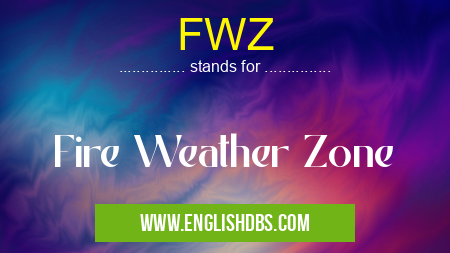What does FWZ mean in UNCLASSIFIED
Fire Weather Zones play a crucial role in wildfire management by:

FWZ meaning in Unclassified in Miscellaneous
FWZ mostly used in an acronym Unclassified in Category Miscellaneous that means Fire Weather Zone
Shorthand: FWZ,
Full Form: Fire Weather Zone
For more information of "Fire Weather Zone", see the section below.
Characteristics of Fire Weather Zones
- Climate and Weather Patterns: FWZs are determined by the climate and weather patterns of the region, such as temperature, humidity, precipitation, and wind speed.
- Fuel Conditions: The availability and type of vegetation in the area, such as forests, grasslands, or brush, contribute to the fire risk and are considered when defining FWZs.
- Topography: The slope, elevation, and shape of the land can influence fire behavior and spread.
- History of Wildfires: Areas with a history of significant wildfires are often designated as higher-risk FWZs.
Purpose of Fire Weather Zones
- Predicting Wildfire Risk: FWZs help forecasters identify areas that are most susceptible to wildfires based on weather conditions and fuel availability.
- Issuing Fire Danger Warnings: Fire agencies use FWZ information to issue fire danger warnings and advisories to the public, advising them of potential fire risks and precautions to take.
- Planning Fire Suppression Efforts: FWZs guide wildfire suppression efforts by providing information about anticipated fire behavior and the resources needed to combat it.
- Educating the Public: Fire Weather Zones increase wildfire awareness and encourage individuals and communities to take necessary safety measures.
Essential Questions and Answers on Fire Weather Zone in "MISCELLANEOUS»UNFILED"
What is a Fire Weather Zone (FWZ)?
A Fire Weather Zone (FWZ) is a geographic area designated by the National Weather Service (NWS) to provide site-specific weather forecasts and fire danger ratings. Each FWZ represents a unique combination of weather and vegetation conditions that influence fire behavior.
Why are Fire Weather Zones important?
Fire Weather Zones help firefighters, land managers, and the public anticipate and prepare for fire conditions. Accurate weather forecasts and fire danger ratings allow them to make informed decisions about fire prevention, suppression, and public safety.
What factors influence the designation of Fire Weather Zones?
FWZs are primarily determined by:
- Topography and elevation
- Vegetation type and density
- Climate and weather patterns
- Historical fire occurrence and behavior
How are Fire Weather Zones used?
FWZs are used by:
- Firefighters to assess potential fire hazards and plan suppression strategies
- Land managers to prioritize fire prevention measures
- The public to stay informed about fire danger and take appropriate precautions
Where can I find Fire Weather Zone information?
You can find FWZ information on the National Weather Service website or mobile app. Each zone has a unique identifier and a forecast that includes current weather conditions, fire danger ratings, and any active or potential fire threats.
Final Words: FWZ (Fire Weather Zone) is a valuable tool for wildfire management, providing critical information about the potential for wildfires and helping to protect lives and property. By understanding the characteristics and purpose of FWZs, individuals can stay informed and take appropriate actions to mitigate wildfire risks.
